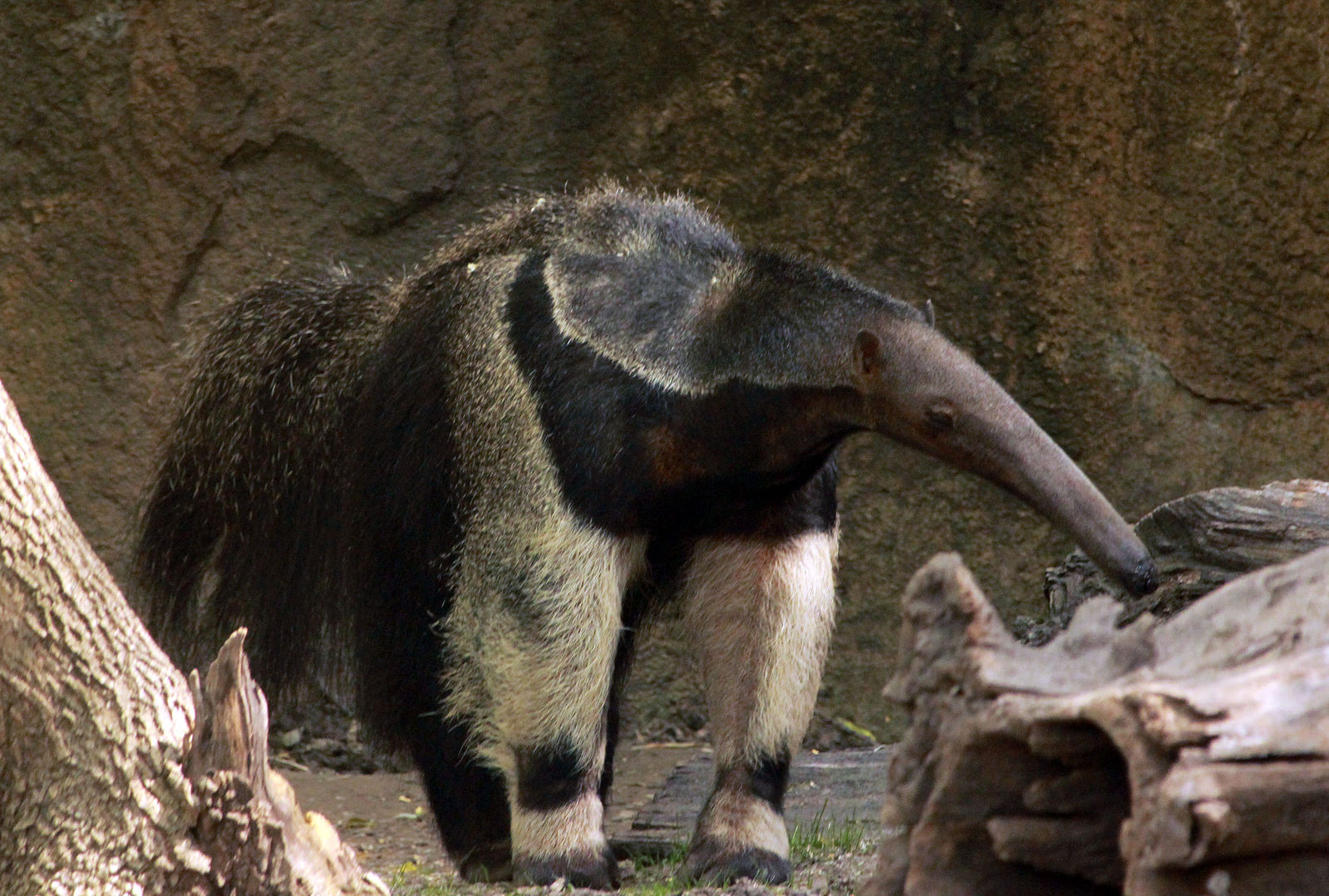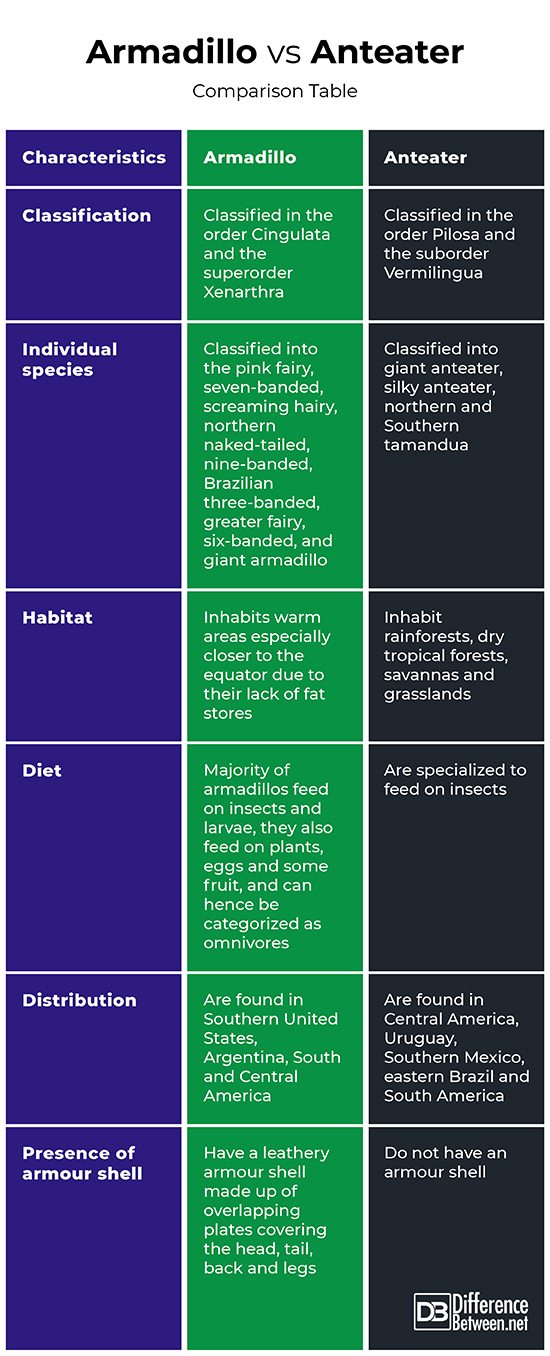Difference Between Armadillo and Anteater
According to a recent survey carried out by the International Union for Conservation of Nature, 28,000 species of animal and plant species risk extinction. This is due to environmental factors such as natural disasters, habitat fragmentation, overexploitation or habitat exploitation. Evolutionary changes including poor reproduction, genetic inbreeding and a decrease in the population number are also among the causes of extinction. For instance, the armadillo and anteater remain vulnerable species especially due to poaching. Although they have various similarities, they have differences.

What is an Armadillo?
Meaning little armoured on, these are placental mammals with nine extinct and 21 extant species. The armadillo belongs in the order Cingulata and the superorder Xenarthra, with all species native to the Americans. According to the Integrated Taxonomic Information System, there are 21 species that vary in size. The largest armadillo is the Giant armadillo, which is about 5 ft. long while with the smallest being the pink fairy armadillo which is about 6 inches long.
The armadillos are nine genera and 21 species which include the pink fairy, seven-banded, screaming hairy, northern naked-tailed, nine-banded, Brazilian three-banded, greater fairy, six-banded, and giant armadillo.
The armadillo is barrel-shaped, have short legs, but can surprisingly move fast. They have long sharp claws and a leathery armour shell made up of overlapping plates covering the head, tail, back and legs. They are also characterized by long sticky tongues and pointy snouts. While armadillos protect themselves from predators by quickly digging a hole, the three-banded armadillo is the only species that can roll itself into a hard armoured ball for protection against predators. With poor eyesight, these species hunt using their highly developed sense of smell.
The species inhabits warm areas especially closer to the equator due to their lack of fat stores. They are however very picky about the habitats, and often base it on the type of soil with a preference for loam or sandy soils for easier burrowing and digging. All armadillo species, apart from the nine-banded armadillo which ranges from the Southern United States to Argentina live in South and Central America.
Although the majority of the armadillos feed on insects and larvae, they also feed on plants, eggs and some fruit, and can hence be categorized as omnivores. The long sticky tongue enables them to catch termites, ants and other insects. They have a gestation period of 2-5 months and often give birth to 1-12 pups in borrows.
Although not endangered species, the population of some species population such as the Andean hairy armadillo has significantly declined by more than 30% in the past 21 years.

What is an Anteater?
Meaning warm tongue, this refers to the four extant mammal species within the order Pilosa and the suborder Vermilingua. The extant species are classified into three genera namely: giant anteater, silky anteater, northern and Southern tamandua.
The species are closely related to the sloths and armadillos. The anteaters have a thin tongue, elongated snouts that enable them to feed on insects easily. Their mouths are also tube-shaped with lips but no teeth. They are also characterized by curved foreclaws which enables them to tear open termite and ant mounds and also for defense. They have long and dense fur for protection against attacks from insects. All species are also characterized by a long prehensile tail apart from the giant anteater. Although these species have poor eyesight, they have a well-developed sense of smell which is advantageous in feeding, foraging and defense.
With different insect preferences from arboreal insects to terrestrial insects, anteaters are specialized to feed on insects. Their tongues are covered with filiform papillae, which are tiny hooks used to hold insects together.
Anteaters range extends from Central America, Uruguay, Southern Mexico, eastern Brazil and South America. They inhabit rainforests, dry tropical forests, savannas and grasslands.
Similarities between Armadillo and Anteater
- Both are characterized by long sticky tongues and pointy snouts
- Although both species have poor eyesight, they have a well-developed sense of smell
Differences between Armadillo and Anteater
Classification
The armadillo is classified in the order Cingulata and the superorder Xenarthra. On the other hand, the anteater is classified in the order Pilosa and the suborder Vermilingua.
Types of Species
The armadillos are classified into the pink fairy, seven-banded, screaming hairy, northern naked-tailed, nine-banded, Brazilian three-banded, greater fairy, six-banded, and giant armadillo. On the other hand, anteaters are classified into giant anteater, silky anteater, northern and Southern tamandua.
Habitat
While the armadillo inhabits warm areas especially closer to the equator due to their lack of fat stores, anteaters inhabit rainforests, dry tropical forests, savannas and grasslands.
Diet
While the majority of armadillos feed on insects and larvae, they also feed on plants, eggs and some fruit, and can hence be categorized as omnivores. On the other hand, anteaters are specialized to feed on insects.
Distribution
Armadillos are found in Southern United States, Argentina, South and Central America. On the other hand, anteaters are found in Central America, Uruguay, Southern Mexico, eastern Brazil and South America.
Presence of armour shell
While armadillos have a leathery armour shell made up of overlapping plates covering the head, tail, back and legs, anteaters do not have an armour shell.
Armadillo vs. Anteater: Comparison Table

Summary of Armadillo vs. Anteater
The armadillos are classified in the order Cingulata and the superorder Xenarthra. They inhabit warm areas especially closer to the equator due to their lack of fat stores and have a leathery armour shell made up of overlapping plates covering the head, tail, back and legs. On the other hand, anteaters are classified in the order Pilosa and the suborder Vermilingua. They inhabit rainforests, dry tropical forests, savannas and grasslands. However, both share similar characteristics including the presence of long sticky tongues and pointy snouts not to mention the poor eyesight, they have a well-developed sense of smell.
- Difference Between Profit Center and Investment Center - July 2, 2022
- Difference Between Anti-Trust and Anti-Competition - June 6, 2022
- Difference Between Stocktaking and Stock Control - June 6, 2022
Search DifferenceBetween.net :
Leave a Response
References :
[0]Geoffrey Bourne. Comparative Anatomy And Development. Elsevier Publishers, 2012. https://books.google.co.ke/books?id=SzvyyE0dP5oC&pg=PA260&dq=Difference+Armadillo+and+Anteater&hl=en&sa=X&ved=0ahUKEwj6uNLg5LPpAhXPTxUIHfU9AKgQ6AEILDAB#v=onepage&q=Difference%20Armadillo%20and%20Anteater&f=false
[1]AntonM & Agusti J. Mammoths, Sabertooths, and Hominids: 65 Million Years of Mammalian Evolution in Europe. Columbia University Press, 2005. https://books.google.co.ke/books?id=O17Kw8L2dAgC&pg=PA48&dq=Difference+Armadillo+and+Anteater&hl=en&sa=X&ved=0ahUKEwj6uNLg5LPpAhXPTxUIHfU9AKgQ6AEINDAC#v=onepage&q=Difference%20Armadillo%20and%20Anteater&f=false
[2]Donald Grayson. The Great Basin: A Natural Prehistory. University of California Press, 2011. https://books.google.co.ke/books?id=HAGgwbjoeEwC&pg=PA67&dq=Difference+Armadillo+and+Anteater&hl=en&sa=X&ved=0ahUKEwj6uNLg5LPpAhXPTxUIHfU9AKgQ6AEIPjAD#v=onepage&q=Difference%20Armadillo%20and%20Anteater&f=false
[3]Image credit: https://commons.wikimedia.org/wiki/File:Gfp-giant-anteater.jpg
[4]Image credit: https://commons.wikimedia.org/wiki/File:Nine-banded_Armadillo.jpg
